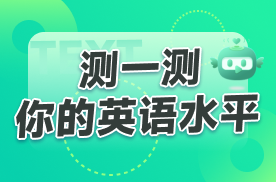2016高考英语听力提前读题的意义
2016-03-24 10:10
来源:互联网
作者:
实际上中考听力中读题是一个很关键的工作,在读听力题时,我们能回忆某些与此相关的内容,从而在听的过程中选择听的内容与回忆内容的重合。下面我们来具体说一下。
第一类:根据听力内容选择答语
如某题的选项有:
A You are welcome B Thank you very much C Thank you all the same.
先回忆一下.A选项表示“不用谢”,所以听力内容大概为Thanks…/Thank you (for)…/It’s kind of you to…. 而B表示“谢谢”可以回答here you are / Can I help you等,C 仍然表示谢谢你,用于你询问别人,别人不知道的时候的回答。本题的听力内容为:I’m sorry,Idon’t know the way to the station,I’m new here. 故而答案应为C。
又如某一题的选项有:
A What a good idea. B With pleasure. C My pleasure.
我们来分析一下,在日常交际用语中A应该用于回答表示建议的句子。如 Let’s…/ Shall we …/ What about…/ Why not…等; B表示“乐意效劳”,常用于别人向你寻求帮助(Can you help me?)时的回答;而C表示不用谢,用于别人向你感谢时的回答。
而听力内容为:Shall we go to the theatre next Sunday? 故而答案应为A。
第二类:根据听力问题,选择答语
如某题的选项为
A It was sunny. B It was Tuesday. C It was January 22,2006.
我们来分析一下,A选项的问题应是What was the weather like?/ How is the weather? 时态应为过去时;B选项的问题应为What day was it …? 时态应为过去时; C选项的问题应为What was the date…? 时态应为过去时。而听力内容为 What day was it yesterday? 故而答案应为B。
又如某题的选项为
A Yes, there is. B Yes, there was. C Yes, there were.
根据这些内容选项A的问题应为 Is there…? B的问题应为Was there..? C的问题应为Were there …? 而听力内容为: Was there a dinosaur show in the Science Museum? 故而答案应为B。
第三类:听对话,每段对后有一个问题,根据对话内容和问题选出答案。某题的选项为:
A She is a nurse. B She is a worker. C She is a teacher.
我们可以从以上选项中看出,对话中谈论的主题应与she 的职业有关,这是我们在听力过程中应特别注意。
听力内容为:M: What does your father do ,Lily?
W: He teaches English just as my mother does.
Q: What does Lily’s mother do?
由此可见,答案应选C。
第四类:听短文,根据听力短文内容,在各题所给的A、B、C、D四个选项中选出一个最佳选项。如某个听力短文有如下的问题和选项:
( )⒗ Where did the young boy's ball fall?
A. In the river. B. Into the net. C. Inside the house. D. In the street.
( )⒘ Why did the boy come back?
A. Because he wanted to get back his ball.
B. Because he wanted to say sorry to the lady.
C. Because he wanted to see the lady.
D. Because his father asked him to come.
( )⒙ Who was the man?
A. The boy's father. B. The boy's teacher.
C. The lady's husband. D. The man the boy asked to come.
( )⒚ Who did the man think the lady was?
A. The boy's mother. B. The boy's sister.
C. The boy's teacher. D. The boy's neighbor.
( )⒛ How much did the man want to fix the window?
A. $10. B. £10. C. ¥10. D. 100 jiao.
从这段听力所给出的问题及选项,我们不难看出,听力要求我们要将短文的地点、起因、人物和一些基本的事件信息要听得出来。所以我们在听的时候要特别留意这些内容。
而这个听力短文的内容为:(划线部分为我们的问题涉及内容)
A young boy was playing with a ball in the street. He kicked it too hard,(第16题) and it broke the window of a house and fell inside. A lady came to the window with the ball and shouted at the boy, so he ran away.(第17题) But he still wanted his ball back. A few minutes later he returned and knocked at the door of the house. As soon as the lady opened the door, he said, "My father is going to come and mend your window very soon."
After a few more minutes a man came to the door with tools in his hand, so the lady let the boy take his ball away. (第18题、20题)When the man finished mending the window, he said to the lady, "Ten dollars, please." (第19题)“ But aren't you the boy's father?”asked the lady, looking very surprised.
故而,答案应为16 C 17 A 18 D 19 A 20 A
又如我们有下面一篇听力短文:
根据所听短文内容, 判断下列句子的正(T)与误(F)。
⒗ The word "hello" is widely used in many countries.
⒘ Thomas Edison was the first man to use the word "hello" on the telephone.
⒙ Telephone was invented by Thomas Edison.
⒚ Edison was good at talking.
⒛ At first, people believed they could hear each other on the phone.
通过阅读上面5个句子,我们初步判断该听力短文与电话、电话用语以及人物Thomas Edison有关。结合我们学过的历史知识,我们知道电话不是Thomas Edison发明的,首先判断第18题为错的(F)。然后,听的重点在hello这个单词以及Thomas Edison身上了
而这个听力短文的内容为:(划线部分为我们的问题涉及内容)
(第16题)Maybe the word "hello" is used more often than any other one in the English language. Every one in the United States and other countries uses the word, again and again, every day of the week.
(第17题)The American inventor Thomas Edison is believed to be the first person to use "hello" on the telephone soon after the invention of it.
(第20题)At first, people began their words on the telephone with "Are you there?" They were not sure the small machine could really carry voices.
(第19题)Edison was a man of few words. He wasted no time. The first time he picked up the telephone, he did not ask if anyone was there. He was sure someone was there and only said "hello".
From then on, "hello" is often heard when you picked up the telephone.
故而,答案应为16 T 17 T 18 F 19F 20 F
总之,我们在作听力时应作到以下几点:
一、争取时间 提前审题。 领到试卷后应迅速浏览听力部分,尽快根据题干和选项预测可能出现的录音内容,努力寻求四个选项之间的差别,提高捕捉信息的准确度。
二、沉着答题 遇难不慌。 听力测试的时间是预先设定的,通常为12分钟左右。因此,要培养抢记内容的能力,如人名、地名、时间、数字等。特别是对那些一时拿不准、写不出的词要学会用音标或缩写词作快速记录,以便在录音结束后为自己创造追忆的条件。另外,如果在做题过程中遇到确实听不懂的,要舍得果断放弃,集中精力,作好后面的题,切不可揪住一点不放,因小失大。
三、仔细检查 理顺关系。听力结束后,不要急于做笔试题。要利用头脑中还保留的短暂记忆和记录的内容,对那些不太肯定的答案进行推敲并合理想象。相对而言,听力第二部分内容难度降低,比较容易得分,做短文理解题时应注意如下几点:(一)、听短文录音时要重在意会,不能搞逐字对译。要特别注意捕捉一篇短文开头的第一句或最后一句话,因为它们往往是该文中心思想所在的主题句。(二)、短文后所给的试题一般是紧扣考生所听到的内容按先后顺序编排的,因此可以根据所听有关内容的先后顺序来逐一考虑各题,以免理不清头绪,解答问题时张冠李戴。(三)、所给出的选项,选择标准往往是看其是否与所听内容吻合。如果仅根据有关语法结构上的基础知识就可判定选择答案的话,该试题就达不到考查听力理解的目的。四、听力结束后有些地方仍然没听清,在答题过程中切忌胡乱猜测,要依据自己已听到的部分内容和已掌握的知识和常识,通过分析、推理等找到最接近的答案。五、短文一般在听两遍的情况下,难以将所有内容全部记忆下来。因此听力前充分利用间隙时间,浏览试题有关书面材料,预测内容。在听力过程中要特别留意并记住有关的信息,提高答题的正确率。
(编辑:何莹莹)







